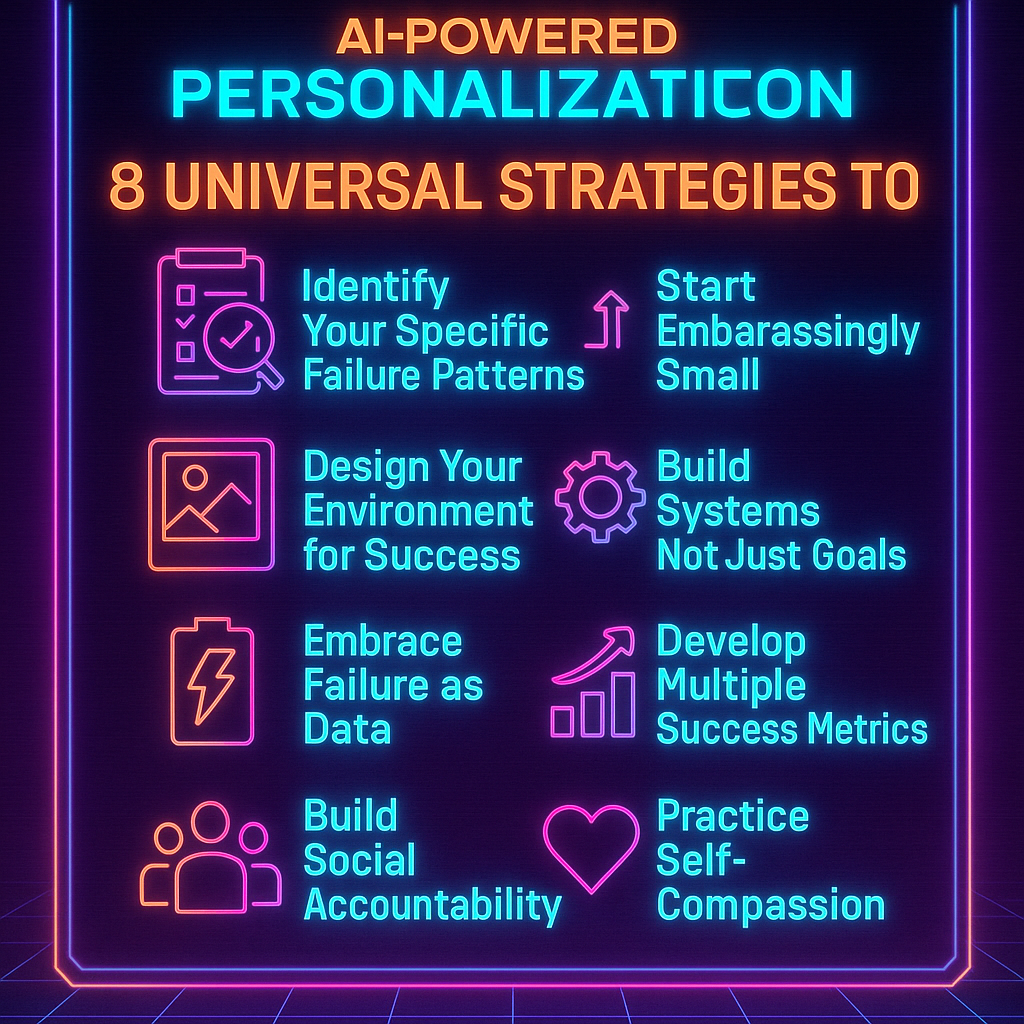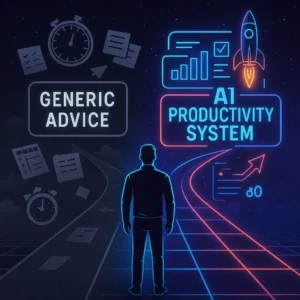What if the key to stop failing at life isn’t more willpower, but smarter intelligence? While most people rely on generic advice and hope for the best, a revolutionary approach is emerging that uses artificial intelligence to identify your specific failure triggers, create personalized success strategies, and build momentum that makes progress inevitable rather than accidental.
The harsh reality is that traditional self-help approaches treat everyone identically, ignoring the fact that your failure patterns are as unique as your fingerprint. Research from Harvard’s Behavioral Insights Group shows that personalized interventions have a 78% higher success rate than generic approaches. Yet most people still rely on one-size-fits-all solutions that weren’t designed for their specific challenges, lifestyle, or goals.
This guide reveals 8 proven strategies that work for most people, plus how to harness AI’s pattern recognition capabilities to analyze your unique situation and customize these approaches specifically for you. Instead of wondering “why do i keep failing” at the same things repeatedly, you’ll have both universal principles and personalized applications that work with your psychology rather than against it.
Why Most People Keep Failing at Life Despite Good Intentions
Dr. Carol Dweck’s research at Stanford reveals something startling: people who repeatedly experience failure often develop what she calls “learned helplessness”—a psychological state where past failures create such strong neural pathways that the brain automatically expects future failures, making them more likely to occur.
This creates a vicious cycle where failing at life becomes a self-fulfilling prophecy. Your brain, trying to protect you from disappointment, begins filtering information to confirm that success isn’t possible for you. It highlights every obstacle while ignoring opportunities, creating what psychologists call “confirmation bias toward failure.”
The problem with most advice is that it assumes everyone has the same triggers, motivations, and obstacles. But research from MIT’s Computer Science and Artificial Intelligence Laboratory identified over 40 distinct factors that influence how people respond to behavior change interventions, including personality type, cognitive processing style, environmental factors, and past trauma responses.
Related Article: Why Do I Feel Like a Failure

8 Universal Strategies to Stop Failing at Life
While personalization is crucial, certain strategies have proven effective across diverse populations. Here are the fundamental approaches that work for most people:
1. Identify Your Specific Failure Patterns
Most people experience failure as a vague, overwhelming feeling rather than recognizing specific, predictable patterns. Successful people document their setbacks to identify triggers, timing, and circumstances that predict when failure is most likely to occur.
Start by tracking when you typically abandon goals or revert to old patterns. Notice environmental factors, emotional states, and thought patterns that precede giving up. This awareness creates the foundation for prevention rather than reaction.
2. Start Embarrassingly Small
The biggest mistake people make when trying to stop failing at life is setting goals that require dramatic behavior changes. Research from Stanford’s Behavior Design Lab shows that sustainable change happens through tiny actions that build into larger transformations over time.
Instead of committing to work out for an hour daily, start with five minutes. Instead of completely overhauling your diet, change one meal. Small actions reduce resistance and create positive momentum that naturally expands into bigger changes.
Read More: How Small Changes Lead to Big Results
3. Design Your Environment for Success
Your environment shapes your behavior more than willpower ever will. Successful people proactively design their physical and digital spaces to make positive choices easier and negative choices harder.
Remove temptations from easy reach, set up visual cues for desired behaviors, and automate as many positive actions as possible. If you want to read more, place books in visible locations and remove distracting apps from your phone’s home screen.
4. Build Systems, Not Just Goals
Goals tell you what you want to achieve, but systems determine what you actually accomplish. Instead of focusing solely on outcomes, create repeatable processes that naturally lead to your desired results.
Rather than setting a goal to “lose 20 pounds,” build a system around meal preparation, consistent exercise timing, and progress tracking. The goal provides direction, but the system creates the daily actions that make success inevitable.
5. Embrace Failure as Data
People who successfully stop failing at life don’t avoid failure—they change their relationship with it. Instead of viewing setbacks as evidence of personal inadequacy, they treat them as valuable information about what doesn’t work.
Each failure provides data about your approach, timing, support systems, or strategies. This reframe transforms failure from an identity threat into a learning opportunity that accelerates future success.
Read More: How to Overcome Fear of Failure
6. Develop Multiple Success Metrics
Binary thinking—where outcomes are either complete success or total failure—sets you up for abandonment when perfect execution becomes impossible. Create multiple ways to measure progress so you can maintain momentum even during challenging periods.
Instead of “workout every day or I’m a failure,” develop tiers like: minimal success (any movement), good success (planned workout), and exceptional success (workout plus additional activity). This flexibility prevents perfectionist abandonment patterns.
7. Build Social Accountability
Isolation amplifies failure patterns while social connection provides resilience and motivation. Share your goals with supportive people who can provide encouragement, accountability, and perspective during difficult periods.
Choose accountability partners who understand your challenges and can provide both support and honest feedback. Regular check-ins create external motivation when internal motivation fluctuates.
8. Practice Self-Compassion
Harsh self-criticism after setbacks typically leads to shame spirals that perpetuate failure cycles. Research shows that self-compassion—treating yourself with the same kindness you’d show a good friend—actually increases motivation and resilience.
When you experience setbacks, acknowledge the disappointment without character attacks. Ask yourself, “What would I tell a friend facing this same challenge?” and apply that same compassionate perspective to your own situation.
Why Do I Keep Failing Despite Knowing What to Do?
One of the most frustrating aspects of failing at life repeatedly is understanding intellectually what should work while continuing to struggle with implementation. This gap between knowledge and action occurs because generic strategies don’t account for your unique psychological wiring, environmental factors, and personal triggers.
The Netflix Algorithm Revolution provides a perfect parallel. Initially, Netflix tried to create universal recommendation systems that would work for everyone. The results were mediocre at best. Everything changed when they shifted to analyzing individual viewing patterns and creating personalized recommendations for each user. Suddenly, user engagement skyrocketed because the system understood what worked for each specific person rather than trying to apply generic solutions.
Your life transformation works the same way. Without understanding your specific failure triggers, optimal motivation styles, and individual success patterns, you’re essentially using Netflix’s old universal algorithm approach while others leverage personalized AI to optimize their results.
How to Stop Being a Failure Through AI-Powered Personalization
While the eight strategies above provide a solid foundation, their effectiveness depends entirely on how well they’re customized to your specific situation, personality, and life circumstances. This is where AI becomes a game-changer, helping you identify which strategies to prioritize and exactly how to implement them for maximum impact.
AI PROMPT TO COPY/PASTE:
“I want to learn how to stop being a failure using the most effective combination of proven strategies customized for my specific situation. Please act as a personalization expert to help me identify which approaches will work best for me and how to implement them effectively.
Please guide me through this analysis step by step, waiting for my response before moving to each next stage:
Step 1: Personal Pattern Analysis
- Looking at the 8 strategies (pattern identification, starting small, environment design, systems building, embracing failure, multiple metrics, social accountability, self-compassion), which 2-3 resonate most strongly with your current situation? a. Example: “Environment design and starting small—I know my space affects my behavior and I tend to set overwhelming goals”
- Which strategy feels most challenging or resistance-inducing for you personally? a. Example: “Social accountability feels scary because I don’t want others to see me fail again”
- What’s your biggest obstacle to implementing any of these strategies consistently? a. Example: “I start strong but lose motivation after 2-3 weeks when initial excitement fades”
Step 2: Customized Implementation Planning Based on your top 2-3 chosen strategies, I’ll help you create a personalized action plan that accounts for your specific obstacles and preferences, with concrete next steps you can take this week.
Step 3: Resistance Reduction Protocol For the strategy that feels most challenging, we’ll develop a modified approach that reduces resistance while still providing benefits, ensuring you don’t avoid something that could be highly effective for your situation.”
Example Implementation:
User: “Environment design and systems building resonate most with me. I know my space affects my behavior, and I’m tired of relying on motivation. Social accountability feels scary because I’ve disappointed people before.”
AI: “Perfect insight. Let’s start with environment design since it provides immediate impact without requiring other people. What’s one area of your life where you keep failing, and how is your current environment set up around that area?”
User: “I want to eat healthier but my kitchen is set up for convenience foods, and I keep ordering takeout when I’m stressed.”
AI: “Excellent example. For environment design: This week, spend 30 minutes reorganizing your kitchen so healthy options are more visible and convenient than processed foods. Place cut vegetables at eye level in the fridge, put nuts and fruits on the counter, and move processed snacks to hard-to-reach cabinets.
For systems building: Create a simple rule like ‘When I feel stressed, I will drink water and wait 10 minutes before deciding what to eat. This gives your brain time to make conscious choices rather than defaulting to stress-eating patterns.
As for social accountability, we’ll start with just one trusted person who you share weekly progress with. Would you prefer someone who offers encouragement or someone who asks good questions to help you problem-solve?”
This approach takes universal strategies and makes them specific, actionable, and tailored to your psychological profile and life circumstances.
Read More: What Makes Life Worth Living
Overcoming Failure: Advanced AI Strategies for Persistent Challenges
For those who have tried multiple approaches and continue struggling, AI can help identify deeper patterns and create more sophisticated intervention strategies that address root causes rather than just symptoms.
AI PROMPT TO COPY/PASTE:
“I’ve tried many approaches to overcoming failure but keep reverting to old patterns. Please act as an advanced pattern recognition specialist to help me identify deeper issues and create breakthrough strategies.
Step 1: Deep Pattern Analysis
- Describe your most persistent failure pattern that seems resistant to change
- What strategies have you tried before, and how long did they typically last?
- What do you think is the real, underlying reason these patterns persist?
Step 2: Root Cause Investigation Based on your responses, I’ll help you explore potential root causes like perfectionism, fear of success, identity conflicts, or unaddressed emotional triggers that may be sabotaging your efforts.
Step 3: Breakthrough Strategy Development We’ll design advanced interventions that address root causes while building sustainable success systems that work with your psychology rather than against it.”
This deeper approach helps people who have failed at life repeatedly to finally break through persistent patterns by addressing underlying psychological factors rather than just surface behaviors.
How to Not Be a Failure: Building Long-term Success Systems
The ultimate goal isn’t just to stop failing at life temporarily, but to build robust systems that make success inevitable over the long term. This requires understanding how to create sustainable momentum that builds upon itself.
AI PROMPT TO COPY/PASTE:
“I want to learn how to not be a failure by building long-term success systems that create sustainable momentum. Please act as a systems design expert to help me create approaches that get stronger over time.
Step 1: Success System Architecture
- What would ‘success’ look like for you in 6 months if everything went well?
- What systems or routines would need to be in place to make that outcome highly likely?
- How could we design these systems to become easier and more rewarding over time?
Step 2: Momentum Building Strategy I’ll help you create interconnected success systems where progress in one area naturally supports progress in others, creating positive feedback loops that make continued success increasingly inevitable.
Step 3: Resilience Integration We’ll build flexibility and adaptation mechanisms into your systems so they become stronger during challenges rather than breaking down when life gets difficult.”
This approach focuses on creating failure-resistant systems that improve with time rather than requiring constant willpower to maintain.
The Limitation: Why Even Personalized Strategies Need Integration
While AI-customized strategies provide powerful improvements over generic advice, they still address challenges in isolation. Stop failing at life permanently requires understanding how different areas of your life interconnect and influence each other.
Failure in one domain often stems from imbalances in others. Career stress affects health choices, which impacts energy levels, which influences relationship quality, which affects mindset—creating complex webs that require comprehensive solutions rather than isolated fixes.
The Complete Solution: Stop Failing at Life Permanently
The strategies you’ve learned represent proven approaches that work when properly customized to your situation. But imagine having an entire system designed around these principles. One that automatically personalizes recommendations, tracks holistic progress, and creates momentum across every area of your life.
🚀 YOU’VE TRIED WILLPOWER—NOW LET AI DO THE HEAVY LIFTING
You’ve experienced how AI can personalize proven failure prevention strategies, but this is only scratching the surface of what’s possible. The Moore Momentum System powered by HabitsCoach.ai represents the evolution of everything you’ve learned. Combining the 8 universal strategies with advanced AI personalization, behavioral science, and gamified progress tracking across all 5 Core Areas of Life.
Instead of manually customizing each strategy and hoping for consistency, our AI automatically analyzes your patterns, predicts obstacles, and adjusts recommendations in real-time. You get the power of proven strategies with deep personalization. And a complete transformation ecosystem that addresses failing at life comprehensively rather than in isolated pieces.
The system transforms your relationship with failure from a recurring nightmare into valuable feedback that accelerates growth. By addressing all five core areas—Mindset, Career & Finances, Relationships, Physical Health, and Emotional & Mental Health—you don’t just implement individual strategies, you create an integrated success framework where progress in any area amplifies results in all others.






